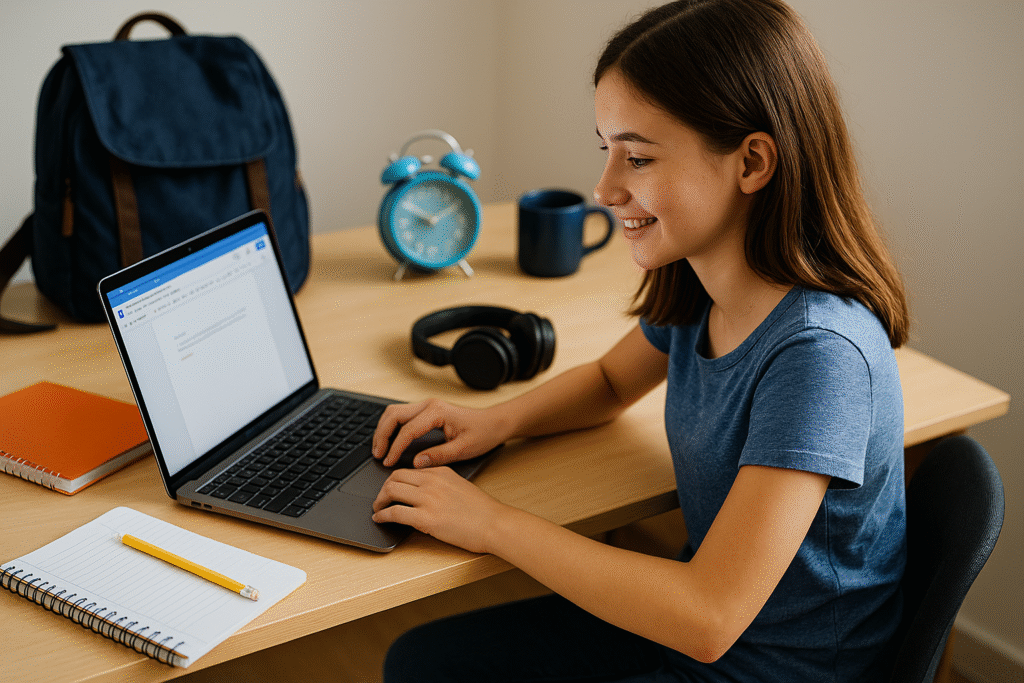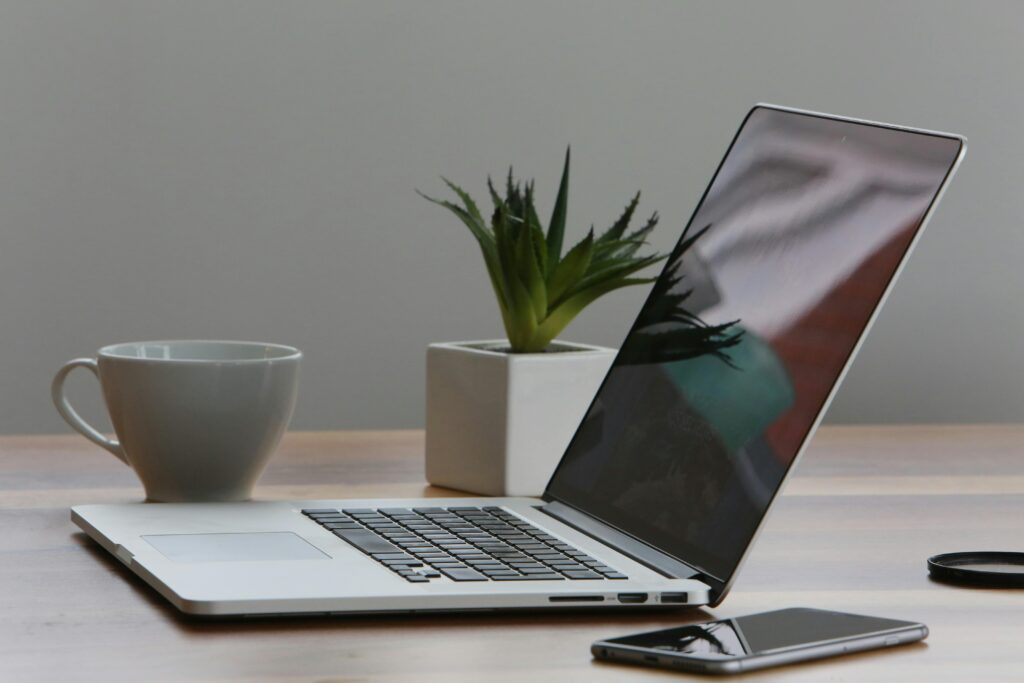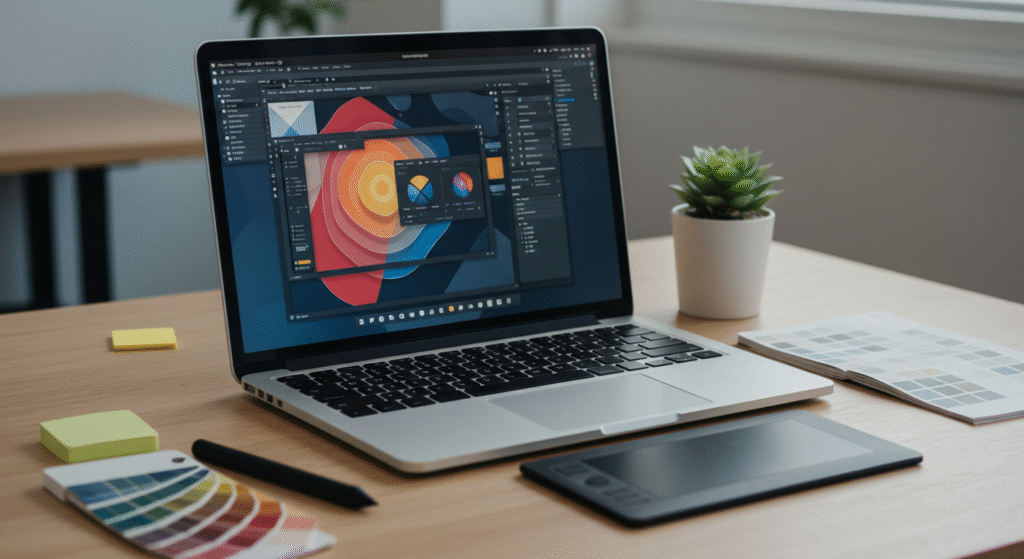Choosing the best laptop for high school students in today’s fast-paced digital classroom can feel overwhelming, especially with so many models, specs, and price points to consider. Whether you’re a student gearing up for your next semester or a parent shopping for a dependable study companion for your teen, getting the right device is more than just checking off a back-to-school list. It’s about making an investment that supports learning, creativity, and productivity—without breaking the bank.
In this article, we’ll walk you through exactly what makes a laptop ideal for high school use, from performance and battery life to durability and budget. We’ll also share our top laptop recommendations tailored to different student needs – whether for coding, content creation, or everyday schoolwork. By the end, you’ll have a clear idea of which laptop is best suited for your academic goals and lifestyle.
What to Look for in a High School Laptop
Choosing the best laptop for high school students isn’t just about grabbing the cheapest deal. It’s about finding the right balance between performance, portability, battery life, and durability. Whether it’s for online classes, research, assignments, or creative projects, a reliable laptop can make all the difference in a student’s academic success.
Here are the key factors to consider when shopping for the right high school laptop:
Performance: Fast Enough to Keep Up
A high school student doesn’t need a gaming rig or a workstation-level machine, but a sluggish laptop can cause frustration. Aim for at least an Intel Core i3 or AMD Ryzen 3 processor. If your budget allows, an i5 or Ryzen 5 gives you more speed and future-proofing. RAM is crucial too—8GB of RAM is the sweet spot for multitasking, browser tabs, and school software.
- Recommended specs:
- CPU: Intel Core i3/i5 or AMD Ryzen 3/5
- RAM: 8GB minimum
- Storage: 256GB SSD (Solid State Drive)
- CPU: Intel Core i3/i5 or AMD Ryzen 3/5
An SSD will boot faster and launch applications much quicker than an HDD, making daily tasks smoother.
Battery Life: All-Day Power for Busy Students
High school schedules are packed—from early morning to late afternoon. A laptop with strong battery life ensures students don’t have to keep searching for outlets during the day. Look for laptops that offer at least 8 hours of battery life, though many newer models exceed this.
Some Chromebooks and ultraportables can even stretch beyond 12 hours, which is ideal for a full day of classes, homework, and video streaming afterward.
Portability: Light Enough to Carry All Day
Students are always on the move—from classrooms to the library and back home. A lightweight, compact laptop is much easier to carry in a backpack. The ideal size is between 13 to 14 inches, which strikes a good balance between screen space and portability.
Try to keep the weight under 3.5 pounds. Some ultrabooks and Chromebooks weigh closer to 2.5 pounds, which is excellent for students who walk or commute.
Display: Bright, Clear, and Easy on the Eyes
A clear, crisp screen is essential—especially for students who spend hours reading and typing. A Full HD resolution (1920×1080) is highly recommended. Avoid anything lower, as it makes multitasking and text clarity harder. Touchscreen and anti-glare displays are nice bonuses, especially for artistic or visual tasks.
- Ideal display features:
- 13–15.6″ screen size
- 1080p resolution
- Brightness of 300 nits or more for classroom and outdoor visibility
- 13–15.6″ screen size
Durability: Built to Survive a School Year
High school students aren’t always gentle with their gear. Laptops that can handle occasional bumps, spills, and daily wear-and-tear are a smart choice. Some models come with spill-resistant keyboards or MIL-STD-810G certification for rugged durability.
If the student is particularly active or clumsy, consider investing in a rugged laptop case or a model marketed for education use, like some Lenovo and HP EDU models.
Top 5 Best Laptops for High School Students in 2025
Finding the best laptop for high school students in 2025 means looking for a machine that’s powerful enough for assignments, durable enough for daily use, and affordable enough for parents. Whether your teen is writing essays, joining virtual classes, editing videos, or managing school projects, the laptops below stand out for their value, versatility, and reliability.
Here are our top 5 picks—each chosen for its unique strengths. We’ve also included a comparison table to help you decide based on budget, performance, and features.
Apple MacBook Air M2 (2024/2025)
The MacBook Air with the M2 chip remains a top-tier choice for students who want performance and premium build quality. It’s ideal for high schoolers involved in creative arts, video editing, or multitasking-heavy subjects like design or media.
- Battery Life: Up to 18 hours
- Weight: 2.7 lbs
- Best for: Creative students or Apple ecosystem users
- Bonus: macOS comes with free built-in productivity tools (Pages, Keynote, iMovie)
Though it’s more expensive than most Windows laptops, its performance and longevity make it a long-term investment.
ASUS Chromebook Plus CX34
If you’re looking for a budget-friendly laptop that’s light, fast, and easy to use, the ASUS Chromebook Plus is a standout. Perfect for students who rely on Google Classroom and web-based tools, this Chromebook boots in seconds and handles day-to-day schoolwork effortlessly.
- Battery Life: Up to 12 hours
- Weight: 2.9 lbs
- Best for: Budget-conscious students using Google tools
- Bonus: Virus protection built-in, no setup required
Chromebooks are especially great for schools with Google Workspace programs and cloud-based assignments.
Dell Inspiron 14
A classic Windows laptop that combines performance with durability, the Dell Inspiron 14 is a great all-rounder. With enough processing power for multitasking and productivity software, it suits students in all academic tracks—from STEM to humanities.
- Battery Life: 9–10 hours
- Weight: Around 3.4 lbs
- Best for: Students needing Windows software and flexibility
- Bonus: Comfortable keyboard and robust build
Dell’s customer support and solid warranty also add peace of mind for parents.
Lenovo IdeaPad Flex 5 (2-in-1)
For students who want touchscreen flexibility, stylus compatibility, and the option to use their device like a tablet, the Lenovo Flex 5 delivers. It’s ideal for sketching, note-taking, and flipping into tent mode for watching educational videos or group work.
- Battery Life: 10–12 hours
- Weight: 3.3 lbs
- Best for: Creative students, note-takers, and tablet fans
- Bonus: Affordable compared to other 2-in-1 laptops
Its performance is solid, and the 360° hinge adds a lot of usability for the classroom.
HP Pavilion x360
A versatile 2-in-1 laptop that can handle both schoolwork and entertainment, the HP Pavilion x360 is great for students who enjoy media or light gaming alongside academics. With its touchscreen, stylus support, and great speakers, it’s a fun and functional hybrid.
- Battery Life: 8–10 hours
- Weight: 3.5 lbs
- Best for: Students who need both study and play
- Bonus: Bang & Olufsen speakers and sleek design
This is a great choice for students who want a stylish, multi-functional laptop without spending too much.
Laptop Comparison Table
| Laptop | Battery Life | Weight | Best For | Operating System |
| MacBook Air M2 | 18 hrs | 2.7 lbs | Creative students, long-term use | macOS |
| ASUS Chromebook Plus | 12 hrs | 2.9 lbs | Budget buyers, web-based tasks | ChromeOS |
| Dell Inspiron 14 | 9–10 hrs | 3.4 lbs | General use, Windows apps | Windows 11 |
| Lenovo IdeaPad Flex 5 | 10–12 hrs | 3.3 lbs | Note-taking, 2-in-1 flexibility | Windows 11 |
| HP Pavilion x360 | 8–10 hrs | 3.5 lbs | Entertainment + school | Windows 11 |
Laptops for Specific Needs
Not all students have the same academic interests or daily requirements, so the best laptop for high school students can vary based on their unique needs. Some students may need high processing power for coding, while others may need a simple, lightweight device for essays and browsing. This section helps match the right laptop to the student’s lifestyle and study habits.
We’ll break it down by category to help parents and students make informed decisions based on usage rather than just specs or price tags.
Best Laptop for Budget-Conscious Students
If affordability is your top concern, don’t worry—there are plenty of capable laptops under $400 that are perfect for basic school tasks. Chromebooks shine in this area, offering speed, simplicity, and security without the high price tag.
- Top Pick: ASUS Chromebook Plus CX34
- Why it’s great: Fast boot times, virus protection, and full integration with Google Classroom
- Battery: Up to 12 hours
- Price Range: $250–$350
Many schools already use Google Workspace, so these devices easily sync with classroom assignments and cloud storage, making them a smart budget buy.
Best Laptop for Students Interested in Coding or Engineering
For tech-savvy students exploring programming, robotics, or engineering, the laptop should have enough muscle to run coding environments like VS Code, Python, and MATLAB. A Windows or macOS system with strong processing power and plenty of RAM is essential.
- Top Pick: Dell Inspiron 14 or MacBook Air M2
- Recommended specs:
- 8GB–16GB RAM
- Intel Core i5/M2 chip
- SSD storage (minimum 256GB)
- 8GB–16GB RAM
- Bonus: Compatible with IDEs and STEM applications
A Windows laptop may offer broader compatibility for specialized programs, while macOS is ideal for app development and clean multitasking.
Best Laptop for Creative Students (Art, Design, Video Editing)
If your child is an aspiring designer, artist, or content creator, a touchscreen laptop with stylus support and a high-resolution display is a must. Tasks like video editing and graphic design require a bit more graphical power and a color-accurate screen.
- Top Pick: Lenovo IdeaPad Flex 5 or HP Pavilion x360
- Recommended features:
- Full HD IPS display
- Stylus compatibility
- SSD and at least 8GB RAM
- Full HD IPS display
- Bonus: 2-in-1 functionality makes sketching and presenting projects easier
For more advanced work, the MacBook Air M2 is another powerful option thanks to its smooth performance and high display quality.
Needs-Based Laptop Selection Chart
| Student Type | Recommended Laptop | Key Features | Price Range |
| Budget-conscious | ASUS Chromebook Plus | Fast, lightweight, cloud-based | $250–$350 |
| Coding/Engineering | Dell Inspiron 14 | Strong processor, Windows compatibility | $500–$750 |
| Creative/Design | Lenovo IdeaPad Flex 5 | Stylus, touchscreen, 2-in-1 | $450–$700 |
| Media & Content Creator | MacBook Air M2 | M2 chip, HD display, long battery life | $900–$1,100 |
Windows vs. macOS vs. ChromeOS – Which is Best for High School Students?
When shopping for the best laptop for high school students, one of the most important decisions is choosing the right operating system. Each option—Windows, macOS, and ChromeOS—offers different strengths depending on the student’s needs, preferences, and school requirements.
This section breaks down the pros and cons of each system to help you pick the best fit.
Windows: Most Flexible for School and Beyond
Windows laptops are the most widely used and compatible with almost every software high school students might need. Whether it’s Microsoft Word, coding software, or video editing tools, Windows can run them all.
Pros:
- Compatible with most school software
- Wide range of prices and brands
- Supports gaming, STEM apps, and more
Cons:
- May require regular updates and antivirus
- Slightly more complex for tech beginners
Best for: Students who need flexibility or want to explore different types of programs, especially in coding or engineering.
macOS: Smooth and Great for Creativity
MacBooks, which run macOS, are known for their build quality, long battery life, and excellent displays. Creative students often love Macs for tools like iMovie, GarageBand, and Final Cut Pro.
Pros:
- Smooth performance and long lifespan
- Great for design, writing, and multimedia work
- Seamless syncing with iPhones and iPads
Cons:
- Expensive
- Limited support for some Windows-only apps
Best for: Students who are into design, video editing, writing, or already in the Apple ecosystem.
ChromeOS: Fast, Safe, and Budget-Friendly
Chromebooks run on ChromeOS, a simple system built around the Chrome browser. These laptops are ideal for students who only need basic tools like Google Docs, Zoom, and web apps.
Pros:
- Super fast startup and very secure
- Affordable and lightweight
- Long battery life
Cons:
- Not ideal for gaming or heavy software
- Limited offline functionality
Best for: Students who do most of their work online and want something fast, affordable, and easy to use.
Operating System Comparison Table
| Feature | Windows | macOS | ChromeOS |
| Price Range | $300 – $1500+ | $899 – $2500+ | $200 – $600 |
| Ease of Use | Moderate | Easy | Very Easy |
| Best For | Flexibility, Coding | Creativity, Design | Budget, Simplicity |
| App Support | Full | Full (limited gaming) | Web-based only |
| Battery Life | 6–12 hours | 10–18 hours | 10–14 hours |
Tips for Buying a Laptop as a Student
Buying the best laptop for high school students doesn’t have to be overwhelming. With a few smart tips, parents and students can find a quality device that fits both needs and budget. From where to shop to when to buy, timing and research can make a big difference.
Here are practical tips to help you make the right purchase.
1. Take Advantage of Student Discounts
Many top brands offer exclusive deals for students. This can include discounted pricing, free accessories, or bonus software.
- Apple Education Store: Save on MacBooks and get free AirPods or gift cards during back-to-school season.
- Dell and HP: Offer education discounts directly on their websites.
- Best Buy Student Deals: With a free membership, students can unlock lower prices on laptops and accessories.
Always ask for student pricing—it’s often not advertised upfront.
2. Shop During Back-to-School or Holiday Sales
The best times to buy a laptop are during back-to-school promotions (July–September) and big sales events like Black Friday or Cyber Monday. These periods often include bundles with free software, extended warranties, or discounts up to 30%.
Pro tip: Sign up for brand newsletters to get early access to deals.
3. Prioritize Warranty and Support
Students rely on their laptops every day. A warranty protects against damage or malfunctions. Brands like Apple, Dell, and Lenovo offer extended warranty options, accidental damage protection, and 24/7 tech support.
Look for:
- At least a 1-year warranty
- On-site or mail-in repair options
- Customer service with good reviews
A support plan gives peace of mind—especially if the laptop is essential for daily schoolwork.
4. Consider Educational Bundles
Some stores bundle laptops with student-friendly extras, such as:
- Free Microsoft Office (Word, Excel, PowerPoint)
- Google One cloud storage offers
- Extended trial software for studying or editing
Always compare what’s included—not just the price.
Quick Reference Table: Buying Tips Summary
| Tip | What to Look For | Example Brands/Sites |
| Student Discounts | Verified school email deals | Apple, Dell, Lenovo, Best Buy |
| Best Times to Buy | Back-to-school, Black Friday, Cyber Monday | Amazon, Walmart, HP Store |
| Warranty & Support | At least 1-year warranty, good tech support | AppleCare, Dell Premium |
| Educational Bundles | Office 365, antivirus, cloud storage | Microsoft, Google One |
Choosing the Best Laptop for High School Students
Finding the best laptop for high school students depends on balancing performance, portability, and price. In this guide, we explored the most important features to consider—like battery life, RAM, and screen quality. We also reviewed top laptop models for 2025, including budget-friendly Chromebooks, powerful MacBooks, and versatile 2-in-1 devices for creative learners.
Different students have different needs, so we also looked at laptops for specific purposes like coding, video editing, and everyday use. Finally, we shared practical tips for saving money, using student discounts, and buying at the right time.
No matter your budget or goals, the right laptop can empower students to succeed, stay organized, and enjoy learning. If you’re still unsure, revisit the comparison charts above or explore reviews from real students.Have a question or want help picking a laptop? Drop a comment below!
You can also subscribe to get more student tech guides or check out our next article: “Top 10 Must-Have Apps for High School Students in 2025.”



